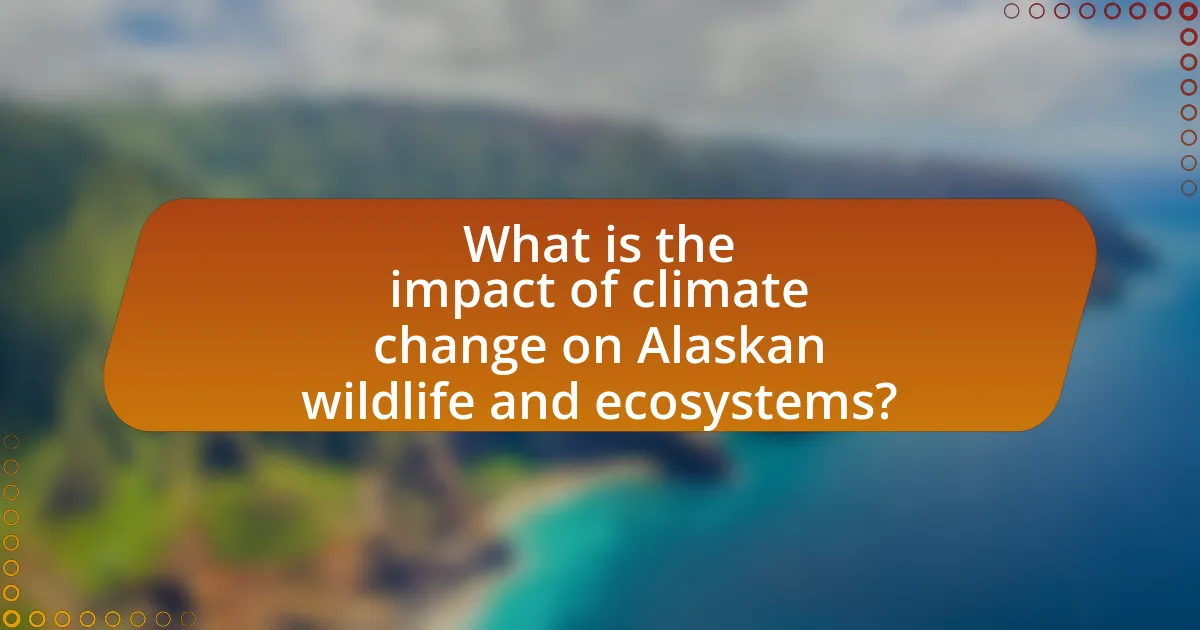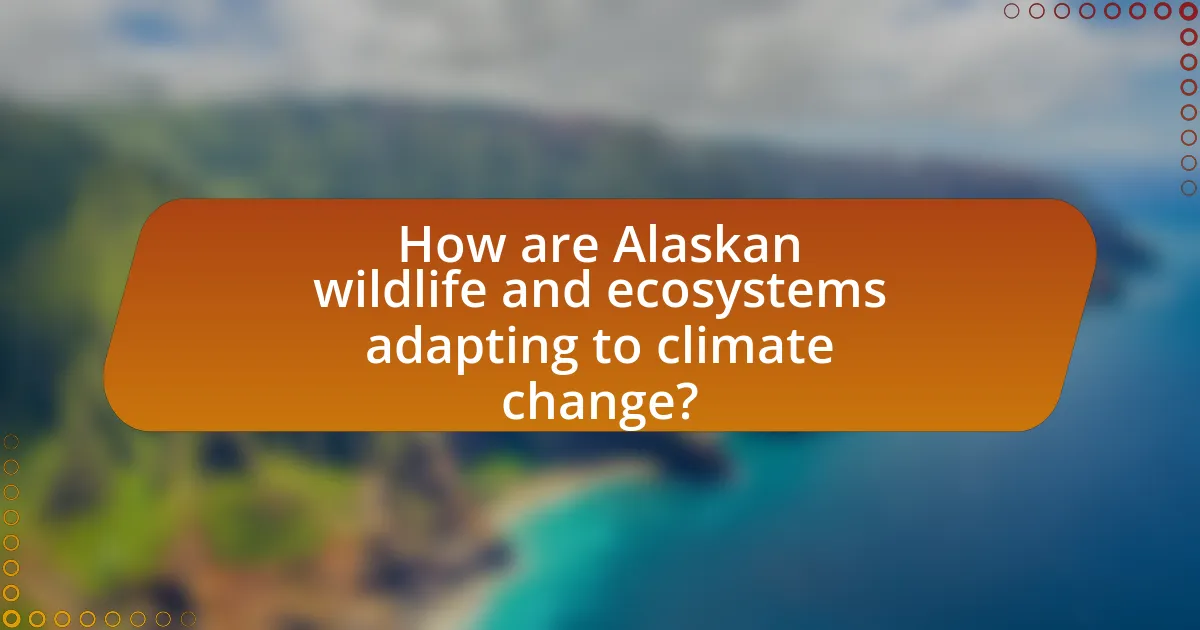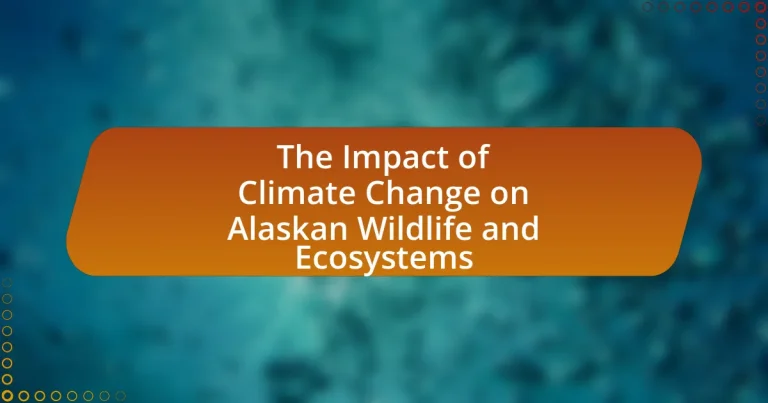The article examines the significant impact of climate change on Alaskan wildlife and ecosystems, highlighting how rising temperatures and altered precipitation patterns affect habitats, food availability, and species interactions. Key species such as polar bears, caribou, and various fish are experiencing shifts in migration patterns, population declines, and changes in reproductive behaviors due to these environmental changes. Vulnerable ecosystems, including tundra, boreal forests, and coastal areas, face threats from habitat loss and invasive species, while the melting of glaciers disrupts freshwater ecosystems. The article emphasizes the urgent need for conservation strategies, habitat restoration, and community engagement to mitigate these impacts and protect Alaskan biodiversity.

What is the impact of climate change on Alaskan wildlife and ecosystems?
Climate change significantly impacts Alaskan wildlife and ecosystems by altering habitats, food availability, and species interactions. Rising temperatures lead to the melting of sea ice, which affects polar bears and seals that rely on ice for hunting and breeding. Additionally, changing precipitation patterns disrupt the growth of vegetation, impacting herbivores like caribou and moose, which depend on specific plant species for sustenance. According to the U.S. Geological Survey, the average temperature in Alaska has increased by approximately 3°F since the 1970s, contributing to these ecological shifts. Furthermore, the introduction of invasive species, facilitated by warmer temperatures, threatens native species and biodiversity.
How does climate change specifically affect wildlife in Alaska?
Climate change significantly affects wildlife in Alaska by altering habitats, food availability, and migration patterns. As temperatures rise, permafrost thaws, leading to habitat loss for species such as caribou and polar bears, which rely on stable ice and tundra environments. Additionally, changing temperatures and precipitation patterns disrupt the life cycles of fish and other aquatic species, impacting food sources for birds and mammals. For instance, the decline of sea ice affects seals and walruses, which depend on ice for breeding and resting. Research from the U.S. Geological Survey indicates that these changes threaten biodiversity and the survival of various species, highlighting the urgent need for conservation efforts in the region.
What are the observable changes in animal migration patterns due to climate change?
Animal migration patterns are shifting due to climate change, with species such as caribou and migratory birds altering their routes and timing. For instance, studies have shown that caribou herds in Alaska are migrating earlier in the spring and later in the fall, which is linked to changes in vegetation growth driven by rising temperatures. Additionally, migratory birds are arriving at breeding grounds up to two weeks earlier than historical averages, as documented in research published by the U.S. Geological Survey. These changes disrupt ecological relationships and can lead to mismatches in food availability and breeding cycles, impacting overall wildlife populations and ecosystems.
How are species populations being impacted by rising temperatures?
Rising temperatures are causing significant declines in species populations, particularly in Alaskan wildlife. As temperatures increase, habitats such as tundra and glaciers are rapidly changing, leading to loss of biodiversity. For instance, studies indicate that warming temperatures have resulted in a 30% decline in certain bird populations in Alaska due to habitat loss and altered food availability. Additionally, marine species like the Pacific cod are shifting their ranges northward, impacting local fishing industries and ecosystems. These changes disrupt the delicate balance of Alaskan ecosystems, leading to further declines in species that rely on stable environments.
What ecosystems in Alaska are most vulnerable to climate change?
The ecosystems in Alaska most vulnerable to climate change include tundra, boreal forests, and coastal ecosystems. Tundra ecosystems are particularly sensitive due to their permafrost, which is melting at an accelerated rate, leading to habitat loss and changes in species composition. Boreal forests are experiencing increased wildfires and pest outbreaks, which threaten their stability and biodiversity. Coastal ecosystems face rising sea levels and increased erosion, impacting both terrestrial and marine species. These vulnerabilities are supported by research indicating that Alaska is warming at twice the global average, significantly affecting these ecosystems.
Which specific habitats are at risk and why?
The specific habitats at risk in Alaska due to climate change include coastal ecosystems, tundra, and boreal forests. Coastal ecosystems are threatened by rising sea levels and increased erosion, which disrupts the habitats of various marine and terrestrial species. Tundra habitats face risks from permafrost thawing, leading to changes in vegetation and increased greenhouse gas emissions. Boreal forests are at risk from increased temperatures and altered precipitation patterns, which can result in more frequent wildfires and pest outbreaks. These changes threaten biodiversity and the overall health of Alaskan ecosystems.
How does the melting of glaciers affect freshwater ecosystems?
The melting of glaciers significantly impacts freshwater ecosystems by altering water temperature, flow patterns, and nutrient availability. As glaciers retreat, they release freshwater into rivers and lakes, which can initially increase water levels but eventually lead to reduced flow as glaciers diminish. This change in flow affects aquatic habitats, disrupting the life cycles of fish and other organisms that rely on stable water conditions. Additionally, the influx of glacial meltwater can raise water temperatures, which negatively impacts cold-water species like salmon, as they require specific thermal conditions for spawning. Research indicates that the loss of glacial ice also reduces the seasonal supply of nutrients, leading to decreased productivity in freshwater ecosystems.
What are the long-term consequences of climate change on Alaskan biodiversity?
The long-term consequences of climate change on Alaskan biodiversity include significant shifts in species distribution, altered ecosystems, and increased extinction risks. As temperatures rise, many species are migrating northward or to higher elevations in search of suitable habitats, disrupting existing ecosystems. For instance, the warming climate has led to the decline of sea ice, which is critical for species like polar bears and seals, resulting in decreased populations and altered food webs. Additionally, changing precipitation patterns and increased frequency of extreme weather events can lead to habitat loss and fragmentation, further threatening biodiversity. Research indicates that by 2100, up to 50% of species in Alaska could face extinction if current climate trends continue, highlighting the urgent need for conservation efforts.
How does climate change threaten endemic species in Alaska?
Climate change threatens endemic species in Alaska primarily through habitat loss, altered ecosystems, and increased competition from invasive species. As temperatures rise, the unique habitats that support these species, such as tundra and coastal ecosystems, are changing rapidly, leading to a decline in suitable living conditions. For instance, the warming climate is causing permafrost to thaw, which disrupts the delicate balance of these ecosystems and can lead to the loss of plant species that endemic animals rely on for food and shelter. Additionally, invasive species, which thrive in warmer conditions, can outcompete native species for resources, further endangering their survival. Studies indicate that species like the Arctic fox and various endemic plant species are particularly vulnerable to these changes, highlighting the urgent need for conservation efforts in the face of climate change.
What role does climate change play in the extinction risk of certain species?
Climate change significantly increases the extinction risk of certain species by altering their habitats, food sources, and reproductive patterns. For instance, rising temperatures and changing precipitation patterns disrupt ecosystems, leading to habitat loss for species such as polar bears and caribou in Alaska. According to the U.S. Fish and Wildlife Service, climate change is projected to cause a decline in suitable habitats for these species, increasing their vulnerability to extinction. Additionally, ocean acidification and warming waters threaten marine species, such as salmon, which are crucial for the food web in Alaskan ecosystems. The Intergovernmental Panel on Climate Change (IPCC) reports that if current trends continue, many species may face extinction by the end of the century due to these climate-related changes.

How are Alaskan wildlife and ecosystems adapting to climate change?
Alaskan wildlife and ecosystems are adapting to climate change through shifts in species distribution, altered migration patterns, and changes in reproductive timing. For instance, many species, such as caribou and migratory birds, are moving northward or to higher elevations in response to rising temperatures. Research indicates that the timing of seasonal events, like the blooming of plants and the arrival of migratory birds, is occurring earlier in the year, which is linked to warmer temperatures. Additionally, marine ecosystems are experiencing changes, with species like cod and salmon shifting their ranges due to changing ocean temperatures and currents. These adaptations are crucial for maintaining ecological balance as climate conditions continue to evolve.
What adaptive behaviors are being observed in Alaskan wildlife?
Alaskan wildlife is exhibiting adaptive behaviors such as altered migration patterns, changes in breeding seasons, and shifts in foraging strategies in response to climate change. For instance, species like caribou are adjusting their migration routes to find suitable habitats as temperatures rise and snow patterns change. Additionally, some bird species are breeding earlier in the season to align with the availability of food resources, which are also affected by climate shifts. These adaptations are crucial for survival as they help wildlife cope with the rapidly changing environmental conditions in Alaska.
How are animals altering their breeding and feeding habits?
Animals in Alaska are altering their breeding and feeding habits primarily due to climate change, which affects their habitats and food availability. For instance, species like the Arctic fox are shifting their breeding seasons earlier in the year to align with changing prey availability, as warmer temperatures lead to earlier snowmelt and increased insect populations. Additionally, polar bears are extending their foraging periods on land as sea ice diminishes, forcing them to adapt their feeding strategies to include more terrestrial food sources. Research indicates that these behavioral changes are critical for survival, as they help animals cope with the rapidly changing environmental conditions in their ecosystems.
What physiological changes are occurring in species as a response to climate change?
Species are experiencing physiological changes such as altered metabolic rates, changes in reproductive timing, and shifts in body size as a response to climate change. For instance, many fish species in Alaskan waters are exhibiting increased metabolic rates due to rising water temperatures, which can affect their growth and survival. Additionally, some bird species are adjusting their breeding seasons to align with earlier spring conditions, which can lead to mismatches in food availability for their young. Research has shown that these physiological adaptations are critical for species survival in changing environments, as documented in studies on Arctic ecosystems that highlight the importance of temperature and resource availability on species’ life cycles.
How are ecosystems responding to the pressures of climate change?
Ecosystems are responding to the pressures of climate change through shifts in species distribution, altered phenology, and changes in community composition. In Alaska, for example, rising temperatures have led to the northward migration of species such as the moose and changes in the timing of plant flowering and animal breeding. Research indicates that these shifts can disrupt existing ecological relationships, as seen with the earlier emergence of insects that may not align with the life cycles of their predators or pollinators. Additionally, the melting of permafrost is releasing greenhouse gases and affecting soil composition, further impacting plant and animal habitats. These responses highlight the interconnectedness of climate change effects on ecosystems and the species that inhabit them.
What shifts in plant communities are being documented in Alaska?
Shifts in plant communities being documented in Alaska include the northward migration of tree species, such as white spruce and aspen, into previously tundra-dominated areas. This change is attributed to rising temperatures and altered precipitation patterns, which favor the growth of woody plants over traditional tundra vegetation. Research indicates that these shifts are leading to increased biomass and changes in species composition, with studies showing a 30% increase in tree cover in some regions over the past few decades.
How are predator-prey relationships changing in response to climate shifts?
Predator-prey relationships are changing due to climate shifts by altering the distribution and behavior of species in Alaska. As temperatures rise, prey species such as caribou and snowshoe hares are experiencing changes in their habitat and food availability, which affects their population dynamics. For instance, warmer winters can lead to reduced snow cover, impacting the foraging behavior of these prey species and making them more vulnerable to predators like wolves and bears. Additionally, shifts in the timing of seasonal events, such as breeding and migration, can disrupt the synchrony between predators and their prey, leading to mismatches in population cycles. Research indicates that these changes can result in decreased prey availability for predators, ultimately affecting their survival and reproductive success.

What actions can be taken to mitigate the impact of climate change on Alaskan wildlife and ecosystems?
To mitigate the impact of climate change on Alaskan wildlife and ecosystems, implementing conservation strategies such as habitat restoration, species protection, and sustainable resource management is essential. Habitat restoration efforts can include reforestation and wetland rehabilitation, which help maintain biodiversity and ecosystem services. Protecting endangered species through legal frameworks and conservation programs ensures their survival amid changing climates. Additionally, sustainable resource management practices, such as regulated fishing and hunting, can prevent overexploitation and support ecosystem resilience. These actions are supported by studies indicating that proactive conservation measures can significantly enhance the adaptability of wildlife and ecosystems to climate change effects.
What conservation strategies are effective in protecting Alaskan wildlife?
Effective conservation strategies for protecting Alaskan wildlife include habitat preservation, sustainable resource management, and community engagement. Habitat preservation involves establishing protected areas, such as national parks and wildlife refuges, which safeguard critical ecosystems and species. Sustainable resource management focuses on regulating fishing, hunting, and logging practices to ensure that wildlife populations remain stable and ecosystems are not overexploited. Community engagement fosters local involvement in conservation efforts, promoting stewardship and awareness of wildlife issues. These strategies are supported by research indicating that protected areas can enhance biodiversity and that sustainable practices can mitigate the impacts of climate change on wildlife populations.
How can habitat restoration contribute to ecosystem resilience?
Habitat restoration enhances ecosystem resilience by re-establishing native species and improving biodiversity, which are crucial for ecosystem stability. Restored habitats can better withstand environmental stressors, such as climate change, by providing essential services like carbon sequestration, water filtration, and soil stabilization. For instance, a study published in the journal “Ecological Applications” found that restored wetlands in Alaska increased biodiversity and improved resilience against flooding and erosion, demonstrating the direct benefits of habitat restoration in mitigating climate impacts.
What role do protected areas play in wildlife conservation?
Protected areas play a crucial role in wildlife conservation by providing safe habitats that protect biodiversity from threats such as habitat loss, poaching, and climate change. These designated regions help maintain ecosystems, allowing species to thrive and adapt to environmental changes. For instance, according to the World Database on Protected Areas, over 15% of the Earth’s land surface is protected, which significantly contributes to the preservation of various species and their habitats. In Alaska, protected areas like national parks and wildlife refuges serve as critical sanctuaries for species affected by climate change, ensuring their survival and promoting ecological resilience.
How can local communities contribute to climate change mitigation efforts?
Local communities can contribute to climate change mitigation efforts by implementing sustainable practices such as reducing energy consumption, promoting renewable energy sources, and enhancing local biodiversity. For instance, community-led initiatives like tree planting and conservation projects can significantly improve carbon sequestration, which is essential for reducing atmospheric CO2 levels. According to the U.S. Forest Service, urban trees can sequester approximately 1.1 billion tons of carbon annually, highlighting the impact of local actions on climate change. Additionally, local communities can engage in educational programs to raise awareness about climate change and encourage sustainable behaviors, further amplifying their mitigation efforts.
What practices can individuals adopt to support wildlife conservation in Alaska?
Individuals can support wildlife conservation in Alaska by participating in local conservation programs, reducing their carbon footprint, and advocating for sustainable practices. Engaging in local conservation programs, such as volunteering for habitat restoration projects or wildlife monitoring initiatives, directly contributes to the preservation of Alaskan ecosystems. Reducing carbon footprints through energy conservation, using public transportation, and supporting renewable energy sources helps mitigate climate change, which is a significant threat to wildlife in Alaska. Advocating for sustainable practices, such as responsible fishing and hunting regulations, ensures that wildlife populations remain healthy and ecosystems are preserved. According to the Alaska Department of Fish and Game, community involvement in conservation efforts has proven effective in maintaining biodiversity and protecting habitats.
How can education and awareness campaigns help in addressing climate change impacts?
Education and awareness campaigns can significantly mitigate climate change impacts by informing the public about the consequences of climate change and promoting sustainable practices. These campaigns enhance understanding of how climate change affects ecosystems, such as those in Alaska, where rising temperatures threaten wildlife habitats and biodiversity. For instance, a study by the National Oceanic and Atmospheric Administration (NOAA) highlights that increased public awareness leads to greater community engagement in conservation efforts, which can help protect vulnerable species and ecosystems. By fostering informed decision-making and encouraging behavioral changes, education and awareness campaigns empower individuals and communities to take action against climate change, ultimately contributing to the preservation of Alaskan wildlife and ecosystems.


